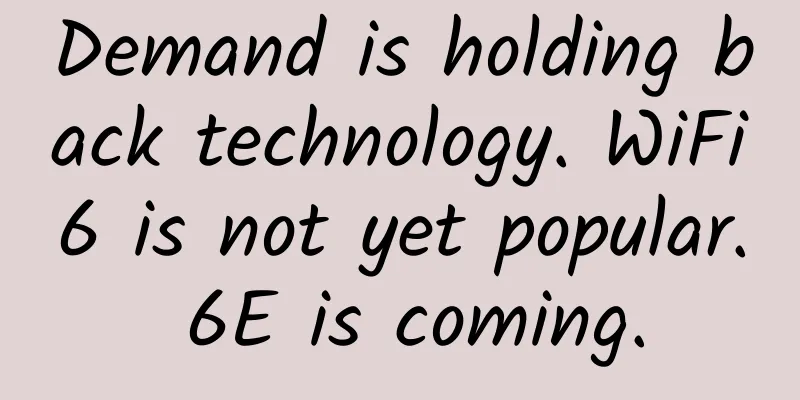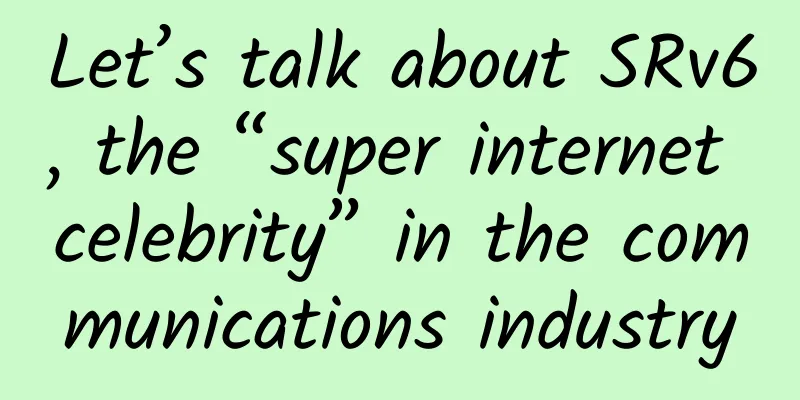Demand is holding back technology. WiFi6 is not yet popular. 6E is coming.

|
As 5G technology develops rapidly, Wi-Fi technology has also ushered in innovation. Now, based on Wi-Fi 6, which has not yet been fully popularized, Wi-Fi 6E has emerged. This seems to prove that advanced technology is being held back by people's needs.
What is the difference between Wi-Fi 6 and 6E? Wi-Fi 6E is the result of an application by Apple, Microsoft, Google and other technology companies in the Wi-Fi Alliance to the Federal Communications Commission (FCC) of the United States to civilianize the 6GHz frequency band in the hands of the US military. Compared with Wi-Fi 6, it brings a new 6GHz frequency band, accommodating 14 additional 80MHz channels and 7 additional 160MHz channels. It will bring faster network speeds and lower latency than Wi-Fi 6. Demand determines the popularity of technology applications In fact, the benefits of the latest wireless network technologies such as Wi-Fi 6 are obvious. Just like 5G communication technology, it can take people's network experience to the next level. But the price to pay is also high, such as the need to update the existing wireless transmission equipment, and the corresponding Wi-Fi module's power consumption will increase.
But compared with these technical problems, the more embarrassing problem is that people currently have no rigid demand for this gigabit-level wireless network. It can only bring a taste of it to a small number of people. What needs hold back technology? In fact, there are many technologies that are in the same awkward situation as Wi-Fi 6. Advanced technologies such as VR/AR and 3D printing, which were popular five years ago, actually have a foundation for implementation, but neither consumers nor businesses have found a hungry market for popularization.
VR glasses were once said to bring people an immersive experience, but now, after searching the entire Internet, only a few old glasses products are still on sale, and a few software that are no longer updated. This is not only due to the performance limitations of mobile devices, but also because the cost of producing related adaptation resources is high. Therefore, after a short-term hype, it has not been popularized. 3D printers, which were promoted as being able to print anything in Industrial Revolution 4.0, are currently only sold on the market for general practical applications such as printing mobile phone cases and small pendants due to material and time limitations. Which technologies have not been left behind? On the other hand, there are also positive cases in network technology. For example, when the 2G network was upgraded to 3G network, it was because people had new demands for traditional text information transmission. People began to send and receive MMS, photos, and music, which made the faster 3G network useful. In the 4G era, due to the demand for video transmission, 4G technology has a demand application space, and has also given rise to the explosion of video self-media, video websites and short videos.
However, with the current 5G, there is still no application scenario that everyone needs. Although the technology is good, it only increases the network speed and reduces the delay after implementation. For 90% of people, it only reduces the loading time of the video by one or two seconds and speeds up the download speed, but this is not enough to drive people to spend more money to replace new 5G mobile phones and tariff packages. Conclusion Whether it is Wi-Fi 6, 6E, 6F, or 6G, if people do not have enough demand for it, its market value cannot be realized. Back to 6E, if 6E is used, Wi-Fi 6 will be directly abandoned before it has started to establish an ecosystem and become popular. Did we invent a technology just to make it useless? |
>>: Faster network/lower latency Wi-Fi 6E is released: stronger than Wi-Fi 6
Recommend
Linveo: $15/year-AMD Ryzen/1GB/25G NVMe/2TB/Ottoville
This is the first time that Linveo has appeared o...
Talking about HTTP connection related knowledge
[[374909]] This article will first introduce the ...
Five-minute technical talk | A brief discussion on WebSocket protocol-RFC 6455
01 Introduction WebSocket is a network communicat...
Mobile networks want to kill WiFi, but it won’t work in China
According to a recent report by OpenSignal Mobile...
The Why and How of a Two-Tier Network Monitoring Topology
As data centers upgrade to 100Gbps at an accelera...
The Internet of Things in the Eyes of Operators: From 0 to 300,000, and then to the stars and the sea
In the forecast of the Internet of Things with tr...
Sharing of practical experience on routing technology pitfalls, have you learned it?
With the rapid development of information technol...
Looking ahead to 2017, who will be the top network technology brand?
[Original article from 51CTO.com] In 2017, the tr...
Fiber Optic Cable Types and Installation Tips
Expanding the presence of fiber optics has become...
Here is everything you want to know about 5G progress and next steps
The progress of 5G has always been a key topic of...
Will wireless networks kill wired networks?
While wireless networks grab all the headlines, w...
Application of multimodal algorithms in video understanding
1. Overview At present, video classification algo...
UFOVPS National Day promotion starts at 30% off, top up 200 yuan and get 20 yuan, Hong Kong CN2/Japan CN2 optional
UFOVPS is currently carrying out a National Day p...
18 pictures tell you: 10 key technical points that a 90-point network engineer should master
"As a network engineer, what does it take to...
Edge Data Centers and the Impact of 5G
A new category of data center will become a major...









